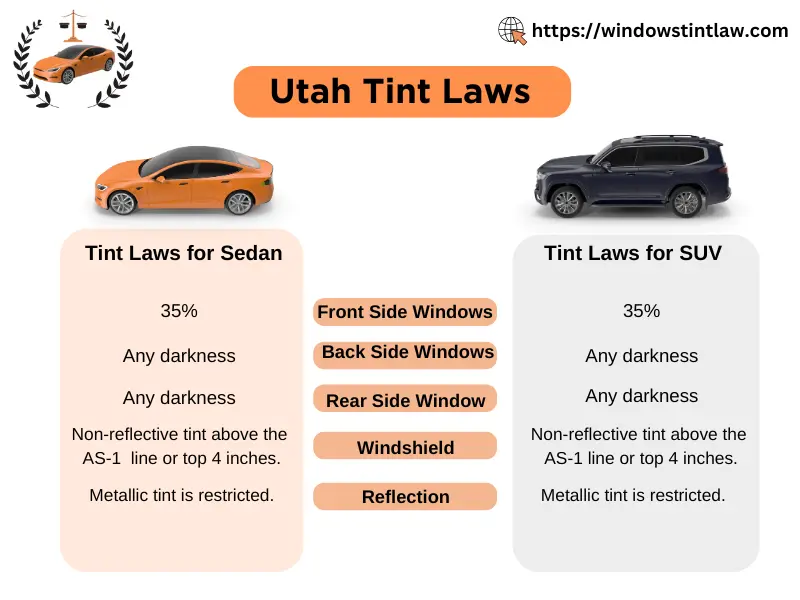Utah tint laws were legislated in 1994 to regulate the legal tinting for Cars and SUVs operated in the state.
Utah tint laws permit to install or apply the window tint that must pass more than 35% of the visible light from the front side windows. Also, The front windshield of vehicles must pass more than 70% of visible light. However tinting material with any VLT Percentage can be applied on the back side windows and rear window.
Window tints offer multiple benefits but disobeying the tint rules may cause tint tickets or some serious legal concerns.
Overview of Utah Tint Laws
The below infographic outlines the window tinting laws of Utah for Sedan and SUV or MPV type vehicles. Drivers are advised to follow these rules in order to avoid legal actions from the state departments.

Darkest Legal Tint in Utah
The below table shows the darkest legal tint limits in Utah. These limits are applicable for Sedan and SUV or MPV type vehicles.
Window Tint Limitations for Cars and SUVs
| State | Front Side Windows | Back Side Windows | Rear Window | Windshield | Tint Reflection | Tint Color Restrictions |
| Utah | 35% | Any darker tint can be applied. | Any darker tint can be applied. | Non-reflective tint above the AS-1 line or top 4 inches of windshield. | Metallic or Mirrored tint is prohibited. | No tint colors are specifically restricted. |
According to Utah Traffic code for Vehicle Equipment, No more than 5% of Tint Variance is allowed. For example, if the maximum VLT for front side windows is 35%, it should not be less than 30%. If less than 30% tint is observed, police officers will issue a tint ticket after testing the illegal window tint with a tint meter.
Window Tint Reflection
According to Utah Code Title 41. Motor Vehicles Section 41-6a-1635, Utah window tinting rules do not allow to install tinting materials on any window that produces metallic or mirror like appearance. Hence vehicle owners or drivers must choose the right type of window tint in accordance with the state laws.
This rule is applied to Sedan and SUV or Multipurpose vehicles.
Other Rules and Regulations
Besides the tint darkness and reflection limits, there are some other rules which are needed to be followed:
- Dual Side Mirrors: Dual side mirrors are mandatory if any window behind the operator seat is tinted.
- Restricted Tint Colors: No tint colors are specifically restricted in the state.
- Certificates: Window Film Manufacturers are not required to get the certification of the film they sell in the state.
- Sticker: Stickers or Label to identify the legal tint is not required to display on the vehicle windows.
Medical Exemption
Utah tint laws do not permit tint waiver or medical exemption certificates for any person due to medical conditions. However many other states of US grants medical exemption certificates if doctor or physician certifies the medical exemption application form.
Penalties for Violating Tint rules
Violation of Window tinting laws is an infraction and any person caught with illegal tint shall be guilty. Sometimes police officers issue a fix it ticket if the tint percentage is not too low, As 5% deviation is legally allowed. However illegal window tints can cost up to $50 for the first offense. Repeated violations may lead to heavy fines and some serious legal actions.
